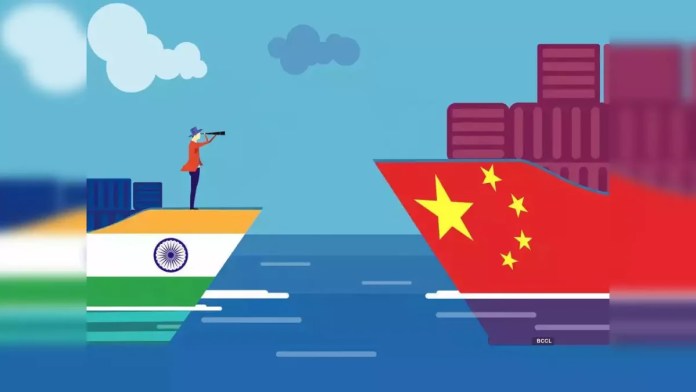While a liberalised India has lamented the flooding of its markets with Chinese goods for more than two decades, China has increasingly found doing business in this country an onerous task, not before the Narendra Modi regime began its innings in 2014, with the latest action involving tax authorities who are investigating under-invoicing of goods imported from the ‘Middle Kingdom’. Trade data have highlighted a glaring difference of around $ 12 billion in the figures sourced from China and India.
Comparing the numbers, the trade data from the two countries show that invoiced imports into India are far less than exports from China to this country. Alarmed by the discrepancy, customs authorities issued tax-evasion notices to 32 importers of Chinese goods since September.
Tax authorities suspect a tax evasion of more than Rs 16,000 crore through under-invoicing by businesses from April 2019 to December 2020. The authorities may issue more such notices in the coming days, sources said.
In a 2019 report, a US-based think tank Global Financial Integrity said that India had lost a mind-boggling $ 13 billion — equivalent to more than Rs 90,000 crore — to ‘mis-invoicing’ in trade and said most of it related to imports from China.
A senior government official said under the condition of anonymity that these imports largely involved electronics goods, gadgets and metals.
Why traders of Chinese electronic goods, gadgets and metals are under-invoicing
Trying to protect domestic production, the Government of India has levied import duties on electronic goods and mobile phones. This increased duty has resulted in a higher rate of “under-invoicing” and tax evasion from China-related businesses to dodge customs duties.
The official trade data show that India imported goods worth $ 79.16 billion from January to September 2022, but customs data from China showed that country’s exports to India stood at $ 89.99 billion in the same period. This gap has only increased over the years.
For instance, in 2019, this gap stood at $ 6 billion as India’s imports from China stood at $ 68.35 billion, while China’s data showed exports at $ 74.92 billion. In 2020, this increased to $ 8 billion in 2020 and $ 10 billion in 2021.
Disclaimer
However, the industry claims that this gap is a result of the time lag in the delivery of consignments and transactions on the high seas and there is not much to it. Some cite the difference in the interpretation of data by different authorities as a probable reason.
Changed Indian approach to China
India is now urging law enforcement agencies to employ a coordinated effort in investigating the finances of Chinese companies. The arrest of a man, described as the “mastermind” behind shell companies linked to China, was a recent sign of New Delhi’s increased pressure campaign on mainland companies in recent months.
The Ministry of Corporate Affairs said in September after the arrest that the suspect had appointed dummy directors onto the boards of these fraudulent businesses, which were potentially involved in “financial crimes detrimental to the financial security of the country”.
According to Alex Capri, a research fellow at the Hinrich Foundation, this amplified crackdown is part of the Modi government’s strategic decoupling from China, which is becoming increasingly important as Delhi builds its own domestic manufacturing base and asserts itself as a global alternative to China for foreign investments. “Moving away from an opaque system, where there is room for these shell companies to operate and a lack of enforcement against corruption, and instead being able to say that we are enforcing the rules properly and we have transparent standards is essential for the long-term investment climate India is seeking,” he explained.
Meanwhile, Chinese telecommunications giants, such as Xiaomi and Vivo, which make up a large share of India’s smartphone market, have come under fire over suspected financial irregularities. In May, India’s financial crime watchdog said it seized $ 725 million from Xiaomi, accusing the Beijing-based firm of illegal remittances. The company was later asked by India’s finance ministry to pay $ 87.8 million in import taxes that it allegedly owed.
Indian authorities also conducted a raid on dozens of Vivo offices in July, seizing 119 bank accounts linked to Vivo India, containing a combined US$58.7 million. The move followed similar investigations of Xiaomi and Chinese telecoms giant Huawei Technologies Co.
Previously in September, the Directorate of Enforcement raided the offices of several payment services under the country’s anti-money-laundering act. The agency said in a statement that Chinese-affiliated apps were involved in “extortion and harassment” of locals who had taken out small loans.
The Modi government had on 26 January 2021 banned Tiktok and 58 other Chinese apps permanently. The Ministry of Electronics and Information Technology issued a new notification to TikTok, WeChat, Bytedance, UC Alibaba browser, and other apps to impose a permanent ban in India (click here for the older, 29 June 2020, government order).
At the same time, a government source said, the government did not want the world to see any politicisation of the global humanitarian crisis that Covid-19 was and, hence, “while India did not ask for it, any aid offered by China during the peak of our nationwide lockdown was not resisted either”.
“But even then,” the source in the Ministry of Commerce said, “India’s decision to toughen foreign direct investment (FDI) regulations provoked China to the extent that it threatened us it would drag us to the World Trade Organisation. We took this step to stop China from acquiring weak Indian companies in the wake of a Chinese company buying more stakes in HDFC.”
China has objected to changes in FDI rules in India, saying that the decision was against the principles of the WTO. Under the new FDI rules made by the Modi government, citizens or companies of any country that shared borders with India would need to seek government approval before investing. Until April 2020, only citizens and companies of Pakistan and Bangladesh needed such approvals.




You must log in to post a comment.